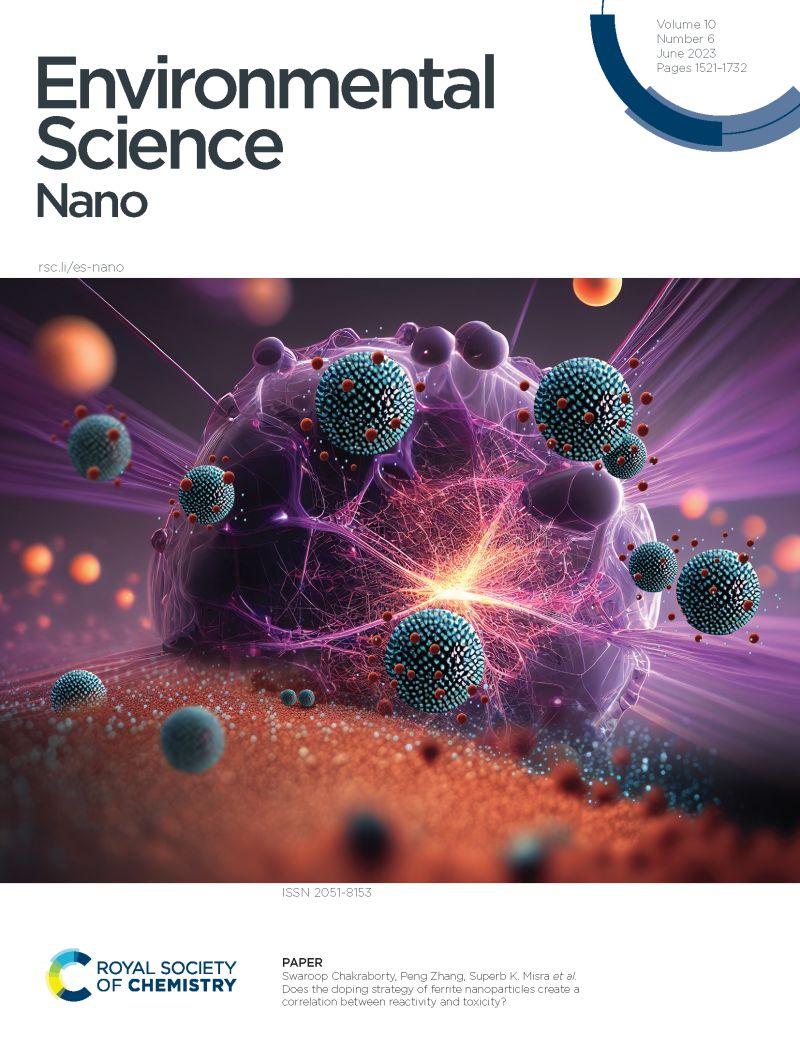Adaptive responses of Bacillus subtilis underlie differential nanoplastic toxicity with implications for root colonization
IF 5.8
2区 环境科学与生态学
Q1 CHEMISTRY, MULTIDISCIPLINARY
引用次数: 0
Abstract
Positively charged nanoplastics are more toxic to microorganisms than their negatively charged counterparts, prompting further investigation into their antimicrobial properties. While many studies have shown that positively charged nanoplastics bind to bacteria, the fate of these nanoplastic coatings during bacterial growth remains unclear. Here, we report how amine-modified polystyrene nanoplastics (PS-NH2) reduce the viability of the plant growth-promoting rhizobacterium Bacillus subtilis and impair its ability to colonize plant roots. We found that upon exposure to PS-NH2, the nanoplastics form stable, multilayer coatings on the surface of the bacteria. In response, B. subtilis initiates processes to remove these nanoplastics—a behavior heavily influenced by their growth environment, whether at air or liquid interfaces. Consequently, we observed differential toxicity under varying growth conditions. Using tomato plant as a model system, we found that these nanoplastics severely inhibit bacterial attachment to plant roots. Our results demonstrate that nanoplastics can disrupt beneficial interactions between soil bacteria and plants, potentially compromising the effectiveness of microbial biofertilizers. Given that current practices introduce large amounts of plastics into agricultural areas, the adverse effects of nanoplastic pollution need to be mitigated枯草芽孢杆菌的适应性反应是纳米塑料毒性差异的基础,对根部定殖具有影响
带正电荷的纳米塑料比带负电荷的纳米塑料对微生物的毒性更大,这促使人们进一步研究它们的抗菌特性。虽然许多研究表明,带正电荷的纳米塑料能与细菌结合,但这些纳米塑料涂层在细菌生长过程中的命运仍不清楚。在此,我们报告了胺改性聚苯乙烯纳米塑料(PS-NH2)如何降低促进植物生长的根瘤菌的活力,并损害其在植物根部定殖的能力。我们发现,接触 PS-NH2 后,纳米塑料会在细菌表面形成稳定的多层涂层。作为回应,枯草芽孢杆菌会启动清除这些纳米塑料的过程--这种行为在很大程度上受其生长环境(无论是空气界面还是液体界面)的影响。因此,我们观察到了不同生长条件下的不同毒性。以番茄植物为模型系统,我们发现这些纳米塑料严重抑制了细菌对植物根部的附着。我们的研究结果表明,纳米塑料会破坏土壤细菌和植物之间的有益相互作用,从而可能影响微生物生物肥料的效果。鉴于目前的做法将大量塑料引入农业区,因此需要减轻纳米塑料污染的不利影响
本文章由计算机程序翻译,如有差异,请以英文原文为准。
求助全文
约1分钟内获得全文
求助全文
来源期刊

Environmental Science: Nano
CHEMISTRY, MULTIDISCIPLINARY-ENVIRONMENTAL SCIENCES
CiteScore
12.20
自引率
5.50%
发文量
290
审稿时长
2.1 months
期刊介绍:
Environmental Science: Nano serves as a comprehensive and high-impact peer-reviewed source of information on the design and demonstration of engineered nanomaterials for environment-based applications. It also covers the interactions between engineered, natural, and incidental nanomaterials with biological and environmental systems. This scope includes, but is not limited to, the following topic areas:
Novel nanomaterial-based applications for water, air, soil, food, and energy sustainability
Nanomaterial interactions with biological systems and nanotoxicology
Environmental fate, reactivity, and transformations of nanoscale materials
Nanoscale processes in the environment
Sustainable nanotechnology including rational nanomaterial design, life cycle assessment, risk/benefit analysis
 求助内容:
求助内容: 应助结果提醒方式:
应助结果提醒方式:


